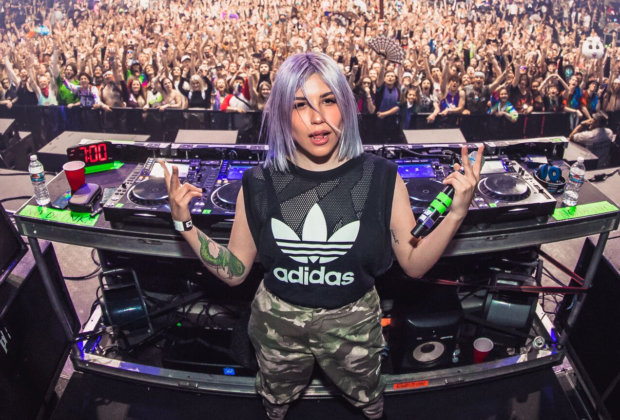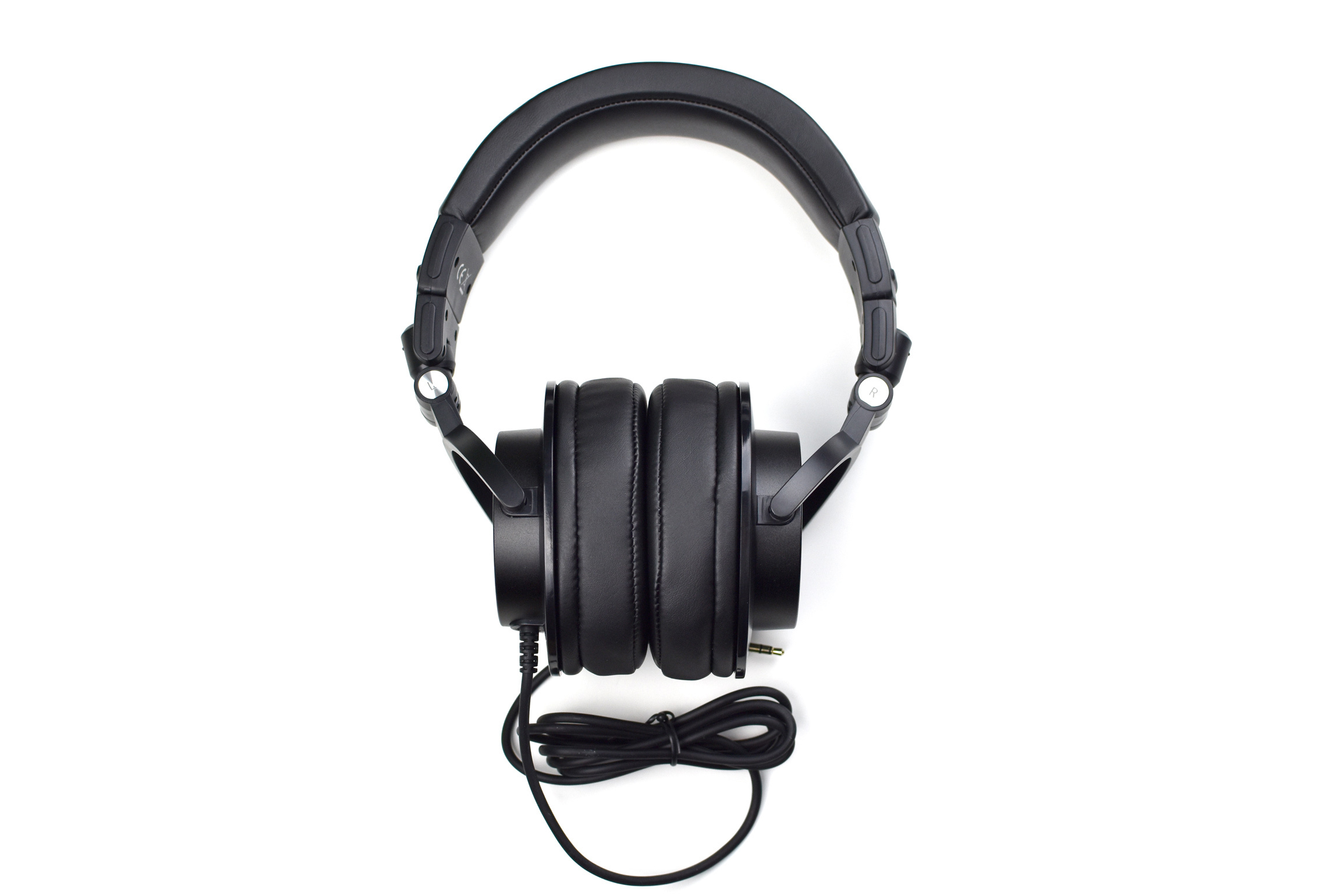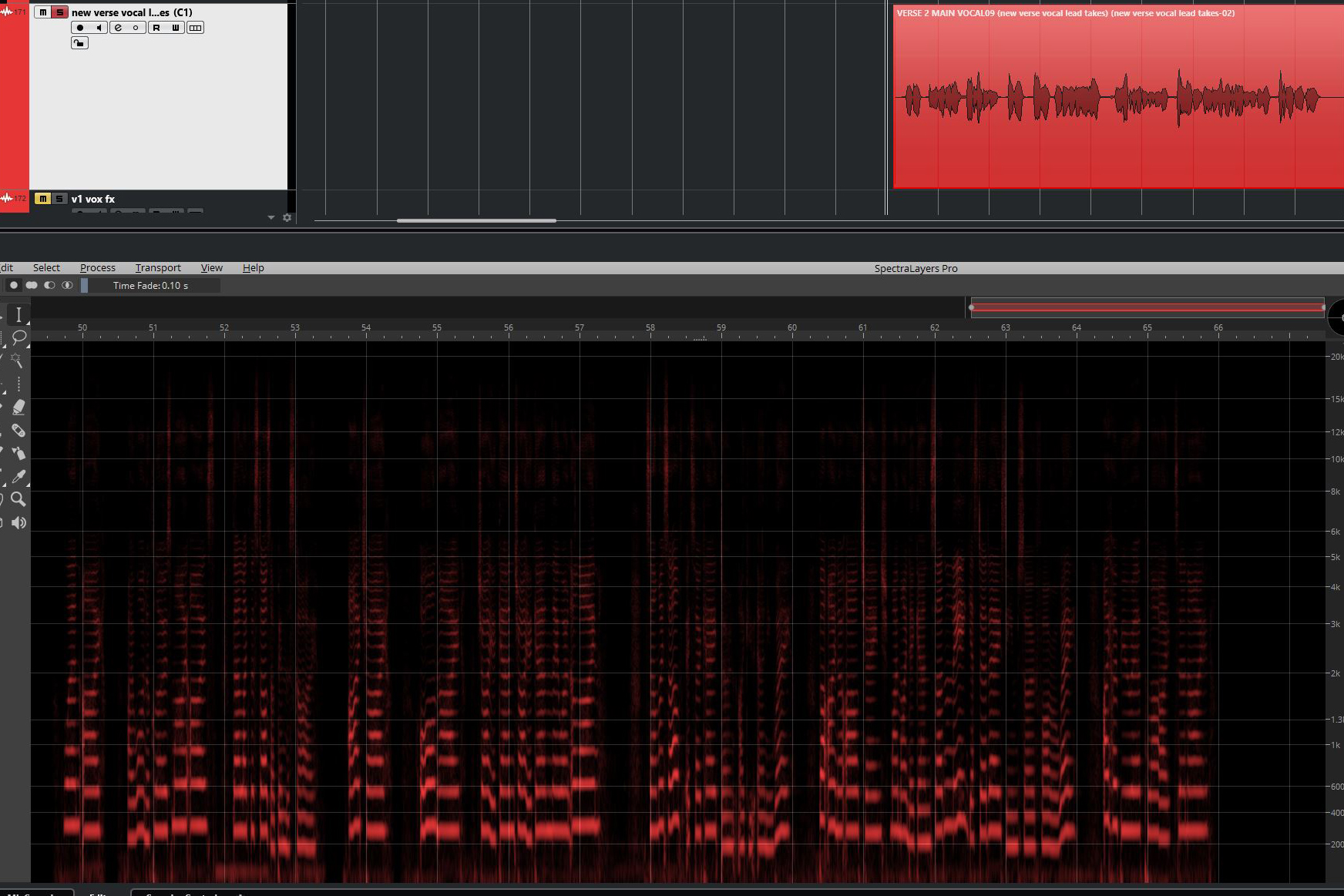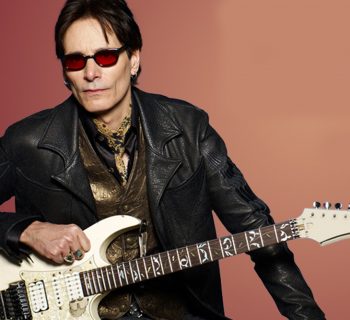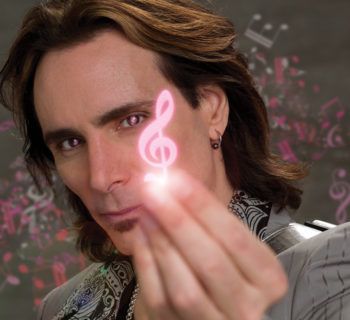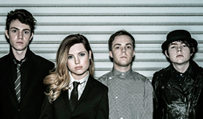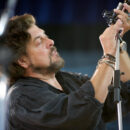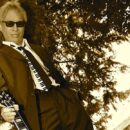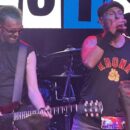Jessica Audiffred
Contact: jessicaaudiffred.com, facebook.com/JessicaAudiffred, soundcloud.com/jessi caaudiffred
Jessica Audiffred began her career as a DJ in Mexico City a decade ago. As she shifted her focus increasingly to her own bass and trap music, Audiffred enrolled in SAE Institute around 2013 and grew into the role of producer. She now runs her label A-Records and has a deal with London-based Circus Records. She performs at countless capacity shows, including last year’s Las Vegas mega-bash Electric Daisy Carnival, which is billed as the largest electronic dance music festival in North America. She found that construction of her own studio proved a bigger challenge than expected, since gear isn’t always easily sourced in Mexico, where she is based.
When and how did you begin to build your studio?
I started as a DJ around 2010, and then about seven years ago I became interested in making my own music. I was doing fine as a DJ, but there’s only so far you can go. So I graduated college with a degree in psychology and then seven years ago started at SAE [School of Audio Engineering]. Just as I was about to graduate, I met my boyfriend, who studied audio engineering and we started work on our studio.
What sets your studio apart?
We didn’t call anyone professional. We did it all ourselves. It’s right next to my terrace, so when you’re fed up at, say, 4 a.m., you can step outside and get some fresh air. I don’t have to leave my house to work. It’s really cozy. There’s nothing expensive or fancy here––just my controller and computer. But it’s good enough to make my tracks.
What are some of the biggest challenges about running your home studio?
It’s definitely expensive, the MIDI controller, computer and monitors especially. I have the [Universal Audio] Apollo Twin interface and for MIDI control I use the Komplete Kontrol S49. My monitors are Focal [Alpha] 80s. It turns out those were really hard to get in Mexico.
What are your favorite tech developments over the past few years?
The plug-in I use the most is [Xfer Records’ wavetable synthesizer plug-in] Serum. I’ve used it ever since I started because it’s so intuitive. I do all of my songs in Serum and then move to other plug-ins. I also like tools from Soundtoys because they’re easy to use and it’s simple to modify your sound. Several of Universal Audio’s plug-ins are also great.
How do you establish a strong relationship with a mix and/or mastering engineer?
My boyfriend is an audio engineer, so he does all of my mixes. But when I release a track with another label, they usually ask for the mix and master it themselves. In electronic music, labels have each artist send their mixes and they’re mastered similarly so that the tracks can sound cohesive.
What’s the biggest challenge you’ve ever faced in your studio?
Putting together all the pieces was hard. In Mexico, audio gear is really expensive. If you want a certain type of interface, there are no physical stores like there are in the States. We can’t just walk in and test gear. When I tried to get my Focus 80 monitors online, it was crazy expensive. They had to be sent on a ship from France, it would have taken three months and I would’ve had to pay all kinds of customs charges. Eventually we found the guy who was the distributor in Mexico, but it wasn’t easy. When you produce bass music, you have to have good low-end monitors. That’s what the Focus 80s gave me.
How important is pre-production?
I have a process and I usually start with the melody. Then I choose my drums and the structure. At the end, I put all the parts together. But if I do a track for a label, it’s usually different. I also start by listening to music I love, which typically inspires me. Often when I try to figure out how a certain sound was done, I come up with something new.
What are the challenges of working in a post-COVID-19 world?
For me, the days are mostly the same. Before COVID-19, I’d tour from maybe Thursday through Sunday or Monday. Then the rest of the days I’d be working in my studio. So it’s kind of similar for me except that I don’t tour.
Any final thoughts?
For electronic music, you should absolutely build your own studio. It doesn’t have to be expensive or fancy. Many of my amazing ideas come early in the morning or late at night. So it’s important to have this creative outlet in your house and not just go to a studio, record something and then go home. If you want to make this a real job, you have to invest in your career and commit to it. You have the best ideas when you have your own studio and the possibilities are endless. If you’re a DJ and don’t have any [original] music, it’s hard to play places. Music will get you there. •
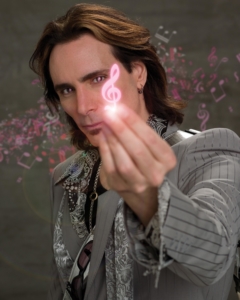
Steve Vai
Contact: vai.com
Guitar wizard Steve Vai discovered multitrack recording in the fourth grade. He amassed an impressive cache of gear early and found that, while to some people it was an expense, to him it became a steady stream of income. Most of what he bought he rented to other musicians and turned a tidy profit. He was tapped by Frank Zappa and later David Lee Roth before he embarked on a prolific solo career. He’s built and owned three professional studios including his current home audio assembly line, Harmony Hut. Three Grammys sit atop his shelf and he’s been nominated for more than a dozen.
When and how did you begin to build your studio?
When I started work with Frank [Zappa], he and his crew supported me as I learned to engineer. He taught me how to edit tape and gave me all sorts of gear. When I bought a house, there was a shed in the back and I converted that to Stucco Blue Studios when I was about 22. That’s where I learned my chops and recorded [his first record] Flex-Able. When I started with Dave [Lee Roth], I bought my second house and put up The Mothership, then about 25 years ago I built The Harmony Hut. It’s not as proper a studio as The Mothership, but it’s much homier, bigger and more relaxing.
What sets your studio apart?
Upon entry, one might not even assume it’s a studio. It’s more like a gentleman’s library. It’s made of wood, fabric and glass and guitars are festooned all over the place. I did a lot of research on studio construction that’s most conducive to capturing live sound. The walls and ceiling are all sort of shifted so it doesn’t create standing waves. I was very methodical about the glass we use, the angles and the protection.
The power in your studio needs to be clean. The Mothership has outlets of two different colors. One is for dirty power, the other is for clean. The clean line is grounded with eight-foot polls that are buried in the yard. If you don’t ground your power, you’ll get a lot of noise in your line. The other thing that’s important is the lighting system. In The Mothership I have Variacs. Without proper lighting protectors, there’s no way you’ll get a clean sound out of your guitar. I didn’t use them at The Harmony Hut and it’s a real problem.
What are some of the biggest challenges about running your home studio?
You have to insulate the walls properly so you can play as loud as you want without disturbing the neighbors. It’s important to have a floating floor and walls. At The Mothership, the whole thing was floating. You couldn’t hear anything outside. The floor doesn’t float at The Harmony Hut, but the walls are all doubled-up. You have to have empty space in between. Vibrations go through anything that’s touching.
Are you content to record your own material or is it necessary to bring in paying clients?
No. I might loan my studio to friends, but The Mothership was a commercial studio. A lot of big artists recorded there.
What have been your favorite technical developments over the past few years?
Almost anything that UA releases is brilliant. The OX [Amp Top Box] was one of the last things that really grabbed my attention as a superior piece of gear. It’s a workhorse.
How do you establish a strong relationship with a mix and/or mastering engineer?
I’ve always handed off my records to Bernie Grundman. The one thing he has that you can’t build is his ears. I’ve experimented with some of the online mastering tools. One that’s really good is LANDR. If it’s a simple project, I’ll master it myself.
What’s the biggest challenge you’ve ever faced in your studio?
A culprit that cuts at the root of your audio real estate is phasing. I can spend hours chasing it. Mics have to be perfectly phased or it just destroys the sound. You’d be surprised what a difference it makes when the bass and kick drum are in sync and they’re in phase. There’s a power that happens on contact. If they’re out of phase, you lose the balls on both.
How important is pre-production?
I usually don’t do it [for myself]. I might have a little acoustic iPhone demo that captures the sentiment of an idea. The seed of the entire song is in there and I know exactly how to go about building it.
What are the challenges of working in a post-COVID-19 world?
I know it’s been difficult for a lot of people. I happen to be one of the fortunate ones who hasn’t been affected. The idea that I don’t have to go out and nobody can come over? That’s a win-win for me. I’m getting a lot of time in the studio without so much interruption.
What’s one of your favorite professional studios in which to work?
Capitol Studios is one. They’ve got a beautiful console in [Studio] B and they just renovated their A room. Ocean Way Studio B is the bomb. There’s another one I love called Wisseloord in Holland.
Any final thoughts?
Most young people being introduced to the industry may have a hankering to record. I highly recommend you get some recording chops by any means necessary. That could mean GarageBand or a simple laptop digital workstation. You get to understand signal flow, and then if you want to expand your horizons you study microphones, pre-amps and converters. People don’t understand the value in having great converters. That’s where your sound is. Another awakening for me was when I recorded entirely in the box: recording and mixing in Pro Tools. When you cram several tracks through a digital buss, they get washed somehow. I did Real Illusions that way and regret it intensely. •
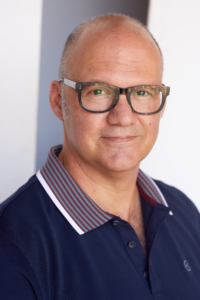
Rob Cavallo
Contact: Through a major studio or
entertainment lawyer
The career path traversed by Rob Cavallo was paved with gold, platinum and diamond records. He signed Green Day and produced Dookie, the band’s 20-million-selling major label debut, as well as the band’s magnum opus American Idiot, both Grammy winners. He’s worked with an honor roll of other platinum-selling artists such as Goo Goo Dolls, Shinedown and My Chemical Romance. For nearly three years Cavallo was the Chief Creative Officer at Warner Music Group and then chairman at Warner Bros. Records for a further six. He’s also won three Grammys himself. Like many, Cavallo was inspired to forge a future in music when he first heard The Beatles.
When and how did you begin to build your studio?
I built my first when I was 17. In 2007 I lived in Hidden Hills and started to work with Doctor Henry Nicholas, who’s the co-founder of Broadcom. He wanted to help me put a studio in my house and brought in all of his heavy-duty tech guys. I hired [Ocean Way owner and engineer] Allen Sides who tuned the room and [Capitol Studios engineer] Art Kelm. We built an honest-to-god serious place. I bought those giant Ocean Way monitors, which I still have. They have four 18-inch woofers, four 15-inch mids and two of those giant horns.
What sets your studio apart?
I have 150 guitars on the wall and about every amp you can imagine. The original head that was used on Dookie is here as well as the ones from Jawbreaker’s Dear You. Many are modded, but some aren’t.
What are some of the biggest challenges about running your home studio?
I made sure that the stereo image was great; that there wasn’t a bad seat in the control room. It took about a year to get the sound perfect. When we first did it, there wasn’t enough absorption in the back; I couldn’t feel the low end. I ripped out the rear wall and put in Owens Corning 703 Rigid Fiberglass absorptive material covered by acoustic sound-passing grill cloth. We made it three feet thick. It always takes a long time to get the patch bay right and then you have to learn the sound of the room. The first record we did there was Shinedown’s The Sound of Madness.
What have been your favorite technical developments over the past few years?
I like all the UA plug-ins and any of the Apollo interfaces. I plug a bass right into my Apollo 8. You can carve anything out of that.
How do you establish a strong relationship with a mix and/or mastering engineer?
Doug McKean and Chris Lord-Alge are great engineers. For mastering, I like Ted Jensen. I was with Bob Ludwig and then he moved. I love him, but I had to fly to New York and then get another flight to Maine. We took American Idiot to Ted. I remember sitting there with the band and listening to [the song] “American Idiot.” The first couple of bars there’s a guitar-through-a-telephone type of effect. Then on the fourth beat of the second bar, the mix opens up and you get bass, drums and guitar and it’s at full range. Ted made it so the first part was loud and the second part was even louder. It was amazing.
What’s the biggest challenge you’ve ever faced in your studio?
Getting the room to sound good was a big one. You almost have to be lucky. There’s a thing called the golden ratio [approximately 1.618] and I always felt that if we stuck close to that with respect to the room dimensions and how we conceive of things, then naturally [things would work]. We’ve all heard stories of guys who spent a lot of money to build a studio and then couldn’t get a good sound out of it; there was no mojo there. That always scared me. There’s nothing worse than being in a control room that sounds too clinical. The first time I walked into Abbey Road’s Studio Two where the Beatles recorded, I almost fell over because I recognized the sound of the room.
How important is pre-production?
Unless I’m producing a rock band, it’s gone away, for the most part. Now we have the computer sitting there and we write the song. Production and conception seem to be one and the same. I can get some samples of a drum, play a live bass to that and it could be the basis of a record. You can do that all in a tiny room.
What are the challenges of working in a post-COVID-19 world?
At first it wasn’t too hard. But we had to spend money and time to figure out what technology to use [for remote work]. Now we’re connected to record in real time where Doug [McKean] is in Woodland Hills and the singer is in Burbank. It took us a few days to get to a free-flowing session without bumming-out the artist.
Any final thoughts?
When I first started, I learned all kinds of engineering tricks and concepts. I put them in a basket and was later confronted with situations and, lo and behold, some of them worked. I used them a lot on records that the public knows; these are records that have sold 20 million copies. Also, it’s a good thing to try to do a record like one that you love. But the thing to take from it is how to arrive at your own sound. Be the first person to make a new one. It’s one of the toughest things to accomplish, but it’s a worthy effort that will pay you back big time. •
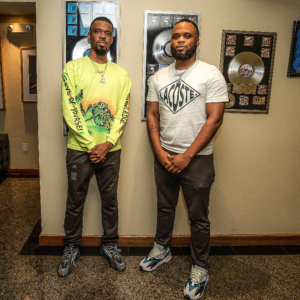
Mosley (Justin and Jordan)
Contact: monomusicgroup.com/clients/mosley, instagram.com/mosleyhd, instagram.com/_jmosley
The Delaware-based production team Mosley––composed of twin brothers Justin and Jordan Mosley––has worked with a number of artists including Post Malone, Kanye West and Kevin Gates. Among the team’s early standouts are Malone’s 2015 single “Too Young” and his 2016 triple-platinum debut Stoney. In 2014 the brothers connected with artist and producer Timbaland when he reached out after they tagged him in one of their Instagram videos. They now share the same management company. The team’s HD Studio was built in 2013 and relies on FL Studio rather than industry stalwart Pro Tools.
When and how did you begin to build your studio?
Jordan: We really started to get into the industry around 2014. Our studio is in the top room of our house. It’s about 20 by 10. We’re coming up with new ideas now. We’ll get rid of the booth, because we’re doing more recording in the main part and other little things that make it easy for us to work faster.
What sets your studio apart?
Jordan: It’s not very large, so the sound is loud. It gives it a club feel and packs a nice punch, which is good because we mostly do hip-hop. It’s soundproofed, but that’s mainly to keep noise out rather than in.
What are some of the biggest challenges about running your home studio?
Justin: We work in FL Studio and a lot of people are accustomed to Pro Tools. We record a certain way that sometimes people aren’t used to, [but] we know how to get the sound that we want from it. In Pro Tools it’s more challenging for us. We produce in FL too so it’s easier to go back in and take sounds and synths out and replay instruments.
Are you content to record your own material or is it necessary to bring in paying clients?
Jordan: Most of the time it’s our own material, but sometimes we bring in people for demos. We don’t work with many outside clients. Sometimes we have other producers of different genres in and we’ll blend it all together.
What have been your favorite technical developments over the past few years?
Jordan: The [UA] Apollo Twin has been a groundbreaker for us. When we go to another studio, it’s kind of universal; everyone has one. We just plug in and go. Recently we started to use [MIDI controller] Komplete Kontrol. It’s the best thing we’ve got in the last few years. It makes production easy, especially for musicians who don’t know the key of a song or scales. If you have a lot of plug-ins, it lets you control them all inside the keyboard.
Justin: Right. It turns non-musicians into
musicians.
How do you establish a strong relationship with a mix and/or mastering engineer?
Jordan: We mix ourselves and I master with iZotope’s Ozone [9] Advanced. You can use a reference song––one by Katy Perry, for example––and it will give you the same dynamics.
What’s the biggest challenge you’ve ever faced in your studio?
Jordan: When you’re home, you need to get the right amount of hours in. It’s too easy to get distracted. Put your phone away.
How important is pre-production?
Justin: We’ll listen to some older records to get inspired. When we work with Timbaland, he’ll give us an idea of what he’s looking for and we’ll spend a week or so listening to those types of records. If it’s a certain artist, we’ll go through his or her catalog. Sometimes we’ll go back to Motown, but usually it’s ‘90s R&B, like Jodeci, Babyface or D’Angelo.
What are the challenges of working in a post-COVID-19 world?
Justin: We can’t fly to other studios or get together with artists. We used to go to Timbaland’s studio three times a month. But we’ve found ways around it, like sending beats to artists.
What’s one of your favorite professional studios in which to work?
Jordan: Timbaland’s The Hit Factory in Miami. It’s a big room and the sound is isolated and very compressed.
Any final thoughts?
Justin: It’s all about comfort. Sometimes people get equipment because they see other people using it. You need to know what works for you. I bought some beat machines one time and it just confused me; it took me away from what I was used to. •

Adrian Young and Todd Forman
Contact: moxybrothers.com, instagram.com/moxybros, twitter.com/moxybros
No Doubt drummer Adrian Young and Todd Forman (sax player and keys collaborator with Sublime and Sublime with Rome) established The Ruby Red Room in Young’s basement in 2018. The two had played together live in the ‘90s and more recently on a number of records, which led to the formation of their production partnership, The Moxy Brothers. Earlier this year they sponsored a contest wherein artists could submit a song. The single winner would receive their production and engineering services for free. It proved an excellent method to source untapped talent. Sandwiched between his music career and today, Forman became a doctor and now strikes a balance between both careers.
When and how did you begin to build your studio?
Young: I’ve filled in as a drummer for a couple of Todd’s bands in the past. He already had his studio and my basement was more of a jam room, but when we started to work together, that’s when I became inspired to build-out a studio.
Forman: I’d always had this edge of music versus medicine. After I moved back to Long Beach, my wife gave me permission to return to music. She didn’t realize that would end up with me on a world tour with Sublime with Rome for 18 months. In 2010 I realized that I loved the process of music production and set up my home studio. I was blown away by all the innovations over the preceding decade and what we could do with a few pieces of gear and software.
What are some of the biggest challenges about running your home studio?
Forman: Time. Both of us love it so much that we’d do it 24/7 if we didn’t have to sleep and eat. But we had built in a schedule before the pandemic hit and we’d get together at least three times a week. We’re able to work asynchronously so we can collaborate after our kids go to bed.
Are you content to record your own material or is it necessary to bring in paying clients?
Young: The process is a huge part of it for us. When artists we work with are excited about something we’ve helped them produce, write or record and they put it on Spotify, that’s fun to watch. We develop artists because creativity and great songs don’t just come in one form, so we don’t limit ourselves only to paying clients.
Forman: We’ve found that we’re good mentors. Many artists come to us with fantastic talent, but sometimes that’s all. You need perspective, realistic goals and to keep your expectations under control, especially in something like the music business. People respond well to us because they understand that we’ve been through and seen a lot.
How do you find/choose clients?
Young: A lot of it is word-of-mouth. But earlier this year we ran a song contest. The winner was an artist named Rozetta Marie from the East Coast. We’d tracked nearly everything and the song was almost done. We were ready to fly out to New York to record her vocals, but then the pandemic hit. Now we’re trying to figure out the technology where we can record and coach her in real time bi-coastal. Audiomovers allows us to share streams and hear the music in super-good quality combined with Zoom for us to see each other.
When you work with clients, do you also collaborate? Do you write, produce and/or engineer?
Forman: Yes, all of the above. We love to write together and Adrian has become quite proficient on guitar. I’m good on melody and play keyboards as well, so it’s whatever the track needs. We’re nimble as performers, writers and producers.
Young: Some bands want us to produce and mix. In the first half of our partnership, we farmed-out our mixes, but now we also do them on the side. We’ve put a lot of time into mixing and I really enjoy it.
What have been your favorite technical developments over the past few years?
Young: I bounce back and forth between plug-ins and hardware, including amplifiers. I love a 1983 Marshall JCM 800. However, some of the Universal Audio amp plug-ins are pretty good. One that I’m really impressed with is their OX [Amp Top Box] attenuator. It takes the load from an amp head and acts as a cabinet simulator. It allows me to crank it super-loud after my kids have gone to bed.
Forman: I like the Spectrasonics plug-ins. Omnisphere is unbelievably important in my repertoire. Stylus and Trilian just make fantastic sounds.
What’s the biggest challenge you’ve ever faced in your studio?
Forman: Some of the problems had to do with connectivity such as UA’s Apollo and Pro Tools. If we started to lay in several Pro Tools plug-ins, we’d get significant latency if we tried to add or record something later. We had to figure out settings and workarounds.
Young: Now we’re getting into UA’s LUNA and we don’t have to mute plug-ins anymore because everything is all under one roof. You’re not playing with a third-party DAW.
What are the challenges of working in a post-COVID-19 world?
Young: Todd and I don’t get together. We do screen shares, bounce files and send them back and forth. We haven’t had anyone come in to sing in a while.
Forman: We plan to bring in a vocalist soon. We’ll isolate her to one room and then we’ll use a makeshift studio outside.
What’s one of your favorite professional studios in which to work? Which ones are the best for drums?
Young: The Record Plant and Ocean Way. Eric Kretz of Stone Temple Pilots had his studio Bomb Shelter in downtown LA and I really enjoyed tracking there. It had a massive drum room and the vocal booth was big enough for a second drum set for super-tight, warm-sounding drums. Now if I want my kit to sound like it’s in a bigger room, I use [UA’s] Capitol Chambers or Ocean Way Studios plug-ins.
Forman: I like Total Access [Recording] in Redondo Beach. It was founded by Wyn Davis and a lot of seminal records were done there. It has a big room with a nice drum sound.
Final thoughts?
Forman: The way technology is these days and the power of plug-ins are both unbelievable. The most important thing in any creative process, especially music, is collaboration. Technology will never farm that out.

